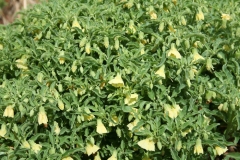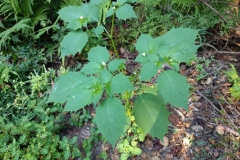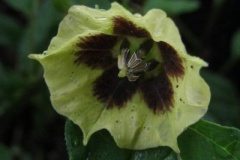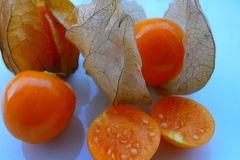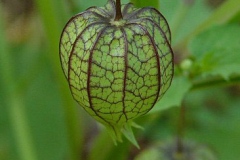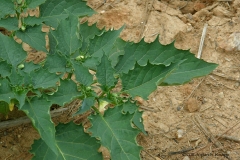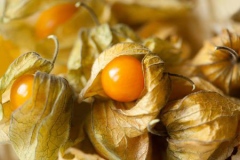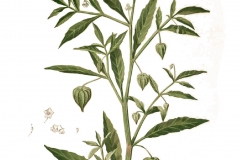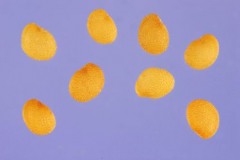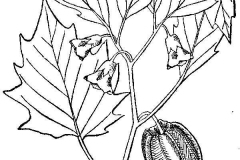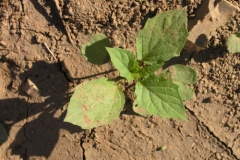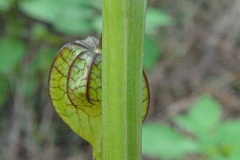| Cutleaf Ground Cherry Quick Facts | |
|---|---|
| Name: | Cutleaf Ground Cherry |
| Scientific Name: | Physalis angulata |
| Origin | Tropical America. It is now distributed pantropically as a weed |
| Colors | Green when young turning to yellowish orange as they mature |
| Shapes | sub globose to ovoid berry that is 1-1.8 cm long and is surrounded in the outer layer |
| Taste | Bitter |
| Health benefits | Heart Disease Prevention, Diabetes Treatment, Wounds Repair, Cancer Treatment, Alzheimer Disease Protection, Infection Resistance, Low cholesterol, Muscle Growth, Urinary Stones Prevention, Cold Treatment, Bone Density Maintenance, Muscle Tissue Damage Prevention, Scurvy Prevention, Immunity Booster, Vision Improvement |
| Plant parts | Medicinal Importance |
| Entire Plant | Childbirth, diuretic, fever, liver diseases, gonorrhea, jaundice, malaria, nephritis, postpartum hemorrhage, rashes, skin sores,
sleeping sickness, to prevent abortion and tumors |
| Fruit | Infection, infertility, inflammation, postpartum infection, pruritis and skin diseases |
| Leaf | Asthma, dermatosis, diarrhea, diuretic, earache, fever, gonorrhea, hemorrhage, hepatitis, infections, inflammation, liver disorders, malaria, postpartum infection, pruritis, rheumatism, skin diseases, prevent abortion and worms |
| Sap | Earache, postpartum infection and pruritis. |
| Root | Diabetes, earache, fever, hepatitis, jaundice, liver disorders, malaria, rheumatism |
| Stem | Hepatitis |
| Seed | Infertility |
Health benefits of Cut Leaf Ground Cherry
Based on the nutrition found in the cut leaf Ground Cherry, here are some health benefits that you can gain for your body by consuming cut leaf Ground Cherry.
1. Heart Disease Prevention
Vitamin C is a good protection for your body because it helps you to keep away from the free radicals that can damage the blood vessels. Such damage is the main cause of one of the deadly diseases, heart disease. That is why this tiny fruit is good not only from keeping the heart disease away, but also other problems related to the cardiovascular. It also reduces the blood pressure and keeps the LDL low while increasing the HDL.
2. Low cholesterol
High level of cholesterols have been associated to numerous severe diseases like stroke, but the good news is the combination of vitamin C and vitamin A from Cutleaf Ground Cherry can keep the body’s cholesterol low. If you like, you may combine Cut leaf Ground Cherry with octopus by creating a unique dish because health benefits octopus for cholesterol includes keeping your heart healthy.
3. Bone Density Maintenance
Another effect of oxidative stress from free radicals is the loss of the bone density. Particularly for women, bone density can lead to osteoporosis when they are aging. Consuming vitamin C helps you maintain the bone density so you can stay healthy.
4. Muscle Tissue Damage Prevention
Vitamin C is also great for preventing soreness and damage in the muscle tissue after doing exercises. It is normal when you experience muscle aches after exercising, but you can reduce it by consuming Cut leaf Ground Cherry regularly in the right portion.
5. Scurvy Prevention
Scurvy is a condition where your body experiences vitamin C deficiency, which results in weakness. The signs can be seen from your hair become curly, the limbs sore and the body exhausted. This condition can be treated by consuming vitamin C rich fruits regularly for a certain period of time to get your body back to its health.
6. Cancer Treatment
There are many health benefits of Cut leaf Ground Cherry. It has been displayed by several researches that consuming vitamin-C rich foods is associated to the cancer treatment including lung cancer, stomach cancer, colon cancer and mouth cancer.
7. Vision Improvement
Although vitamin A benefit has been known all over the world, at least you need to know that consuming Cut leaf Ground Cherry helps you fill your vitamin A daily requirement. The ability of vitamin A in improving the vision includes preventing blindness and dry eyes since it helps your eyes to adapt better to the darkness and light.
Moreover, it helps to keep the retina healthy resulting in cataract prevention. More interestingly, combined with vitamin C this vitamin can even provide better protection from cataract since the deficiency of vitamin C has been associated to it.
8. Cold Treatment
Cold and cough are signs that your immune system starts weakening, so when it happens you can consume vitamin C as the natural treatment. It improves the immune system and helps your body recover faster. At the same time, it improves your body’s iron absorption and infection resistance, which also do the job.
9. Diabetes Treatment
Vitamin C is quite helpful in treating diabetes because it encourages the glucose and insulin processed. This is why research showed the connection between vitamin C deficiencies with diabetes.
10. Urinary Stones Prevention
Vitamin A has calcium phosphate formation that contributes in preventing urinary stones. By keeping the urinary tract lining in its shape, vitamin A in Cut leaf Ground Cherry reduces the risk of stones formed in the tract.
11. Immunity Booster
Both vitamin A and vitamin C are immunity boosters. They can aid the body fight infections while enhancing the white blood cells’ activities in the body. Apart from protecting your body from germs, they also fight them to go out once they enter it. Double vitamins providing double protections gained from a tiny fruit are an amazing fact.
12. Infection Resistance
Cut leaf Ground Cherry has got vitamin C as well as vitamin A which enhance the creation of the white blood cells that keeps harmful microorganisms away. You can get your body supplied with Cut leaf Ground Cherry when you get cold because it has the two great vitamins to help you recover.
13. Muscle Growth
If you have teens and children, encourage them to eat Cut leaf Ground Cherry because its vitamin A guarantees their muscles properly grow. Moreover, it also helps keep the bones in their shapes.
14. Wounds Repair
One of vitamin C benefits you can gain from Cut leaf Ground Cherry is getting wounds repaired better. By promoting the growth of the connective tissues, vitamin C is good for repairing wounds. You can consume Cut leaf Ground Cherry to help your wounds healed faster from the inside.
15. Alzheimer Disease Protection
Consuming Cut leaf Ground Cherry may help you away from Alzheimer disease since it consists of vitamin C. Research showed that consuming more than 500 mg of vitamin C combined with vitamin E can lower the risk. You can actually have other vitamin-C-rich-fruits, but including it into your list is great.
Traditional uses and benefits of Cut leaf Ground Cherry
- In Central, South America and the Caribbean, Physalis angulata is widely used as a medicinal plant in traditional medicine.
- In Curaçao and Jamaica, the herb infusion is taken for gonorrhea, and in Trinidad for indigestion, nephritis and fever; and for toothache in Puerto Rico.
- Leaves are popularly used in Guatemala for the treatment of gonorrhea.
- Plant decoction is used to treat upset stomach and Bright’s disease; the leaves mixed with other plant ingredients in rum as a preservative is used in treatment of skin diseases; the seeds are cooked with Phyllanthus amara seeds in a preparation administered to women to facilitate labor in Guyana and Surinam.
- Different extracts and infusions of fruit and plant parts are commonly used in traditional medicine for the treatment of malaria, asthma, hepatitis, dermatitis and rheumatism and as anti-mutagenic, anticoagulant, antispasmodic and anti-leukemia agents in Brazil.
- Roots are boiled with roots of uruca and acai and drank as herbal tea for jaundice and inflamed liver in Brazil.
- Sliced and softened root decoction in rum is used for treating diabetes in Peruvian herbal medicine.
- Root infusion is used for hepatitis.
- Leaf infusion is used as a diuretic; decoction of leaf and fruit is applied onto inflamed areas as anti-inflammatory and disinfectant.
- Leaf infusion is administered for asthma and postpartum infections.
- Leaf decoction is used for malaria and crushed green fruit paste is used for scabies.
- Various parts of the plant have been used as a febrifuge anthelminthic, anti-rheumatic, diuretic, analgesic and for treating gonorrhea, hemorrhoids, otitis, hepatitis and malaria in Peru.
- Leaves used to treat cutaneous and subcutaneous parasitic infection, whitlow lesions, wounds, diarrhea, dysentery, eye disorders, stomach disorders, asthma, lithiasis, anuria, African trypanosomiasis, measles, small pox, chicken pox in tropical Africa.
- Leaves are applied to infected scarification wounds and Guinea worm sores and used externally for rheumatic pain.
- Fruit is considered to be a tonic, diuretic and purgative in the Punjab.
- The mundas of Chhota Nagpur mix the juice of the leaves with water and mustard oil and use it as a remedy against earache.
- Plant is also extensively used for various ailments in traditional medicine in Southeast Asia and Papua New Guinea.
- Malays are reported to poultice the plant for headache and an infusion taken for intestinal pains in Peninsular Malaysia.
- Leaves smeared with oil and heated were applied to ulcers.
- Decoction of the plant and Plantago major leaves were used for gonorrhea and as diuretic.
- In Sarawak, the Malays use a poultice of the plant for headaches; the Selako bolid the plant with salt and the solution is used as gargle for toothache.
- Decoction of the roots is drunk to treat hypertension and diabetes in Sabah.
- Chewed roots are applied to the lower abdomen to reduce stomach pain in Brunei.
- Pounded leaves are used for headache and itches.
- Leaves had been used as vermifuge and an extract for fever in Indonesia.
- Fruits are used for treating epilepsy, dysuria, jaundice, bleeding gums, dropsy, urinary disorders and gout.
- Herb infusion is used as a remedy for hepatitis, influenza, bronchitis, throat infections and orchitis in Sulawesi.
- Leaf decoction is drunk to treat constipation; leaf sap aqueous solution is taken as an abortifacient in Papua New Guinea.
- Seeds are recorded as a remedy for sterility in Solomon Island.
- Herb is used as a diuretic, anti-diarrhea and anti-pyretic in Thailand.
- An aqueous solution of the crushed plant is drank for oral abscesses or topically applied to them.
- Root decoction is used to treat diabetes and hypoglycemia in Philippines.
- Leaves are analgesic and used externally throughout tropical Africa to treat skin ailments such as itch, smallpox pustules, whitlow lesions, infected scarification wounds and rheumatic pain, and to relieve muscular stiffness and pain.
- Lotion prepared from the leaves is applied to treat ophthalmia in children.
- Leaves are eaten or applied as an enema to cure stomach-ache, colic, lithiasis and anuria, and are added to palm wine to cure fever and to calm attacks of asthma, vomiting and diarrhea.
Culinary uses
- Fruits are edible, juicy and a good source of vitamin C.
- Raw fruit can also be used as a vegetable.
- In tropical Africa, the fruit is eaten as snack or in sauces.
- In several countries, the raw leaves are consumed as salad although bitter.
- Its roots and epigeal parts are taken as tea or infusion, as traditional medicine in some countries.
Cautions of Cut leaf Ground Cherry
Cut leaf Ground Cherry is truly great and amazing, packed with many nutrients. However, there are still some things to put into account before consumption to prevent some unwanted conditions.
Poison
It is recommended that you eat the ripped Cut leaf Ground cherries because the unripe ones are said to be poisonous. Some studies and reports showed that some bad conditions can happen from the consumption of unripe Cut leaf Ground cherries. So you must pay attention to always let them ripen before eating.
Allergies
Although this condition is rarely found, those who are allergic to berries may have to avoid this fruit too. You should also put this fruit out of your diet list if you can’t tolerate vitamin C just in case it leads to some allergy symptoms.
References:
https://www.itis.gov/servlet/SingleRpt/SingleRpt?search_topic=TSN&search_value=30590#null
https://davesgarden.com/guides/pf/go/89478/
http://www.hear.org/pier/species/physalis_angulata.htm
https://npgsweb.ars-grin.gov/gringlobal/taxonomydetail.aspx?id=102388
https://pfaf.org/user/Plant.aspx?LatinName=Physalis+angulata
https://www.cabi.org/isc/datasheet/40711
https://plants.usda.gov/core/profile?symbol=PHAN5
http://www.theplantlist.org/tpl1.1/record/kew-2549815
https://en.wikipedia.org/wiki/Physalis_angulata
https://pdfs.semanticscholar.org/275d/d5737523e676e9a1d2ad651bffcffd92e62c.pdf
http://luirig.altervista.org/schedenam/fnam.php?taxon=Physalis+angulata
http://www.theplantlist.org/tpl1.1/record/kew-2549815
https://uses.plantnet-project.org/en/Physalis_angulata_(PROTA)
https://indiabiodiversity.org/species/show/230736
https://gd.eppo.int/taxon/PHYAN
http://www.hrpub.org/download/20161030/FST1-11107415.pdf
https://innovareacademics.in/journals/index.php/ijpps/article/view/6657/6890



